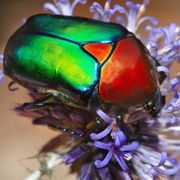Fire Ants and Stucco-Eating Snails: TA Mayor Tours Israel’s Leading Nature Research Hub
From stinging jellyfish to birds colliding with airplanes, Tel Aviv’s natural environment faces both threats and opportunities. So it was only fitting that during Mayor of Tel Aviv-Yafo Ron Huldai’s recent visit to TAU, the city’s longtime leader immersed himself in the pioneering nature research being carried out on campus, and visited the construction site of the Steinhardt National Collections of Natural History Building. The Steinhardt project will form the centerpiece of the most comprehensive center in Israel for biodiversity research, education and conservation.
Mayor Huldai saw firsthand selected treasures of the collections, which number about 5 million specimens of flora and fauna, and took particular interest in research being conducted into Tel Aviv’s urban nature.
Among the presentations by TAU zoologists, two focused on invasive species that cause harm to Tel Aviv’s swim enthusiasts and fishermen. Dr. Noa Shenkar discussed the swarms of jellyfish found in the waters off the city, and the early identification project she is working on to protect the city’s bathers, while Dr. Jonathan Belmaker spoke about an invasive fish species in the Mediterranean that is damaging the local fishing industry. Also, Dr. Menachem Goren presented the Yarkon bleak, a native Tel Avivian fish that he has succeeded in saving and reintroducing into its natural habitat through the establishment of a breeding core at TAU’s Zoological Gardens.

Pictured: Dr. Netta Dorchin talked about two species of cockroaches found in the sands of Tel Aviv’s coastline
On land, Prof. Abraham Hefetz spoke of aggressive little fire ants that have reached Tel Aviv, and Dr. Efrat Gavish-Regev of poisonous spiders found in homes in the city, while Henk Mienis explained how the arrival of the giant African snail was causing damage to dwellings, with the ability to eat through stucco walls. And in the air, Dr. Roi Dor and Dr. Tamar Feldstein discussed the problem of birds colliding with aircraft, including planes taking off and landing at Tel Aviv’s Sde Dov Airport, just a few kilometers from TAU’s campus. Notably, the Zoological Museum developed the national laboratory for bird strike identification, providing support to the Airports Authority and the Israeli Air Force in promoting flight safety.
Pride of a city, icon of a country
The Steinhardt Building will provide these researchers and more with the cutting-edge technology and facilities needed to further advance their work. Upon completion, the 8,000 square meter building will provide a permanent home for TAU’s Zoological Museum, Biological Anthropology Museum, National Herbarium and public education program. The Zoological Museum's specimens underpin hundreds of research projects on conservation, ecology, climate change, wildlife species, pollution, agriculture, and human health, and the Biological Anthropology Museum records the evolution of humans in the Middle East from 1.5 million years ago up until the present day.
Noting Mayor Huldai’s decade-long involvement in the project, Prof. Tamar Dayan, Director of TAU’s Steinhardt Collections and Zoological Museum, thanked him for the provision of the prime building site, the city's assistance with an underground car park, as well the speeding up of the permit process. Prof. Dayan, the driving force behind the initiative, also hailed the invaluable support of TAU Governors and major benefactors Michael and Judy Steinhardt, the Rothschild Foundation (Yad Hanadiv), in addition to Israel’s Ministries of Environmental Protection, Agriculture and Rural Development, Tourism, and Science, Technology & Space, and the crucial funding and involvement of the Planning and Grants Committee of the Council of Higher Education, whose chairman, Prof. Manuel Trajtenberg, joined the visit.


Pictured: A rendering of the complete Steinhardt National Collections of Natural History Building
As Prof. Dayan stressed, these collective efforts are vital, providing support for 70 personnel and hundreds of scientists who use the natural history collections for research every year, in addition to numerous government agencies that receive professional and scientific support from the collections staff. Moreover, the collections are used for teaching about 1000 students every year, and for the for public program ‘Nature Campus’, which, together with the zoological and botanical gardens, opens the collections to approximately ten thousand visitors a year - a number that is expected to rise significantly once the Steinhardt Building opens.
Throughout the visit, Mayor Huldai asked numerous questions, showing great interest in the multi-faceted research being conducted at TAU. He also gave the go ahead for the Tel Aviv-Yafo Foundation, dedicated to raising money for the improvement of the city, to fundraise for the Steinhardt project.
Others present during the visit were Mr. Zvi Kanor, CEO of the Tel Aviv-Yafo Foundation; Dr. Itamar Borowitz, acting Chairman of the Scientific and Public Council of the Steinhardt Natural History Collections; Prof. Joseph Klafter, President of Tel Aviv University; Mr. Amos Elad, TAU Vice President for Resource Development; and Prof. Moshe Mevarech, Dean of the George S. Wise Faculty of Life Sciences.




